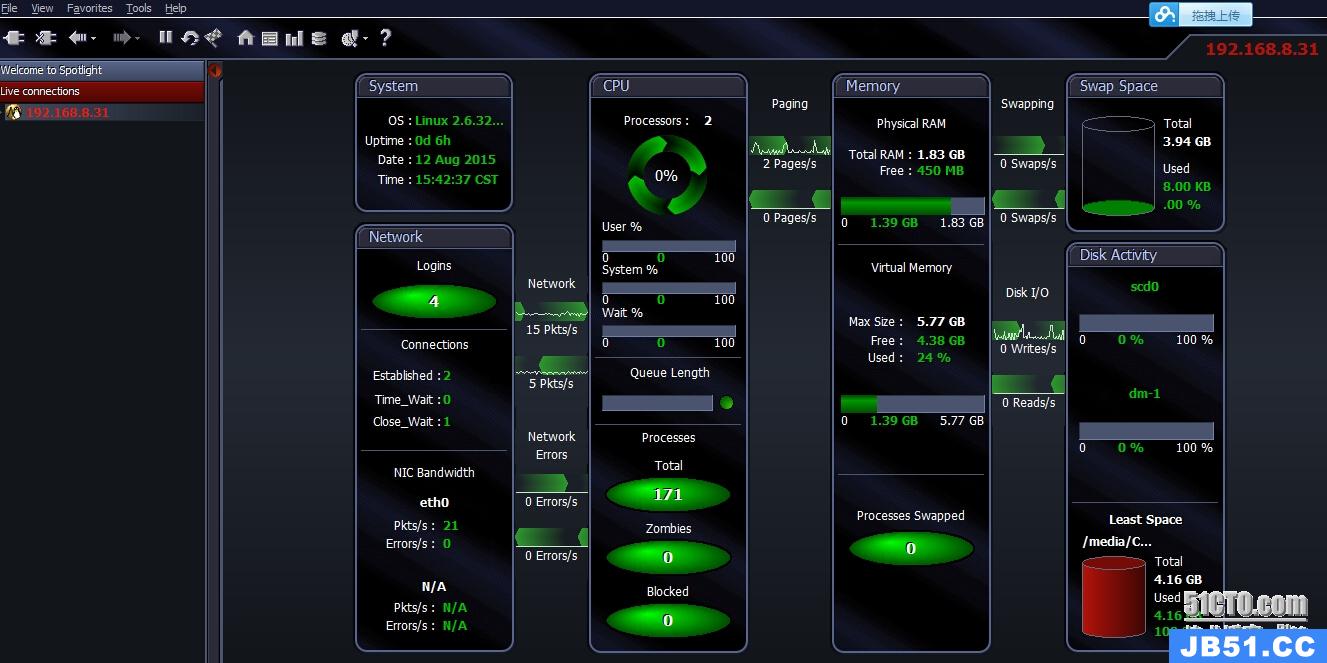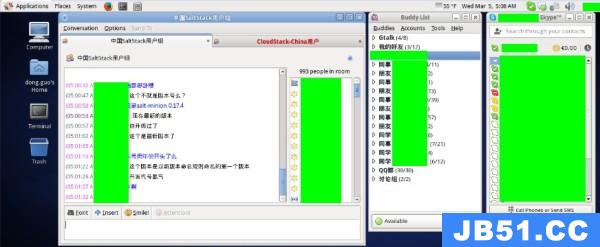最近在搭建Openstack以及Ceph的集群,由于集群中都存在多个节点,且节点间需要时间的同步,所以需要使用NTP,又考虑到有些时候网络环境是封闭的,所以需要自己搭建一个NTP的服务器
| 服务器IP | 角色 | 说明 | 同步方式 |
| 192.168.100.203 | NTPD服务 | 1、负责与外部公共NTPD服务同步标准时间 2、作为内外网络的NTPD服务 | NTPD服务平滑同步 |
| 192.168.40.xxx | 内外NTP客户端 | 内网设备与192.168.100.203同步时间 | NTPD服务平滑同步 |
NTP时间同步方式选择
NTP同步方式在linux下一般两种:使用ntpdate命令直接同步和使用NTPD服务平滑同步。有什么区别呢,简单说下,免得时间长了,概念又模糊。
现有一台设备,系统时间是13:00,真实的当前时间(在空中,也许卫星上,这里假设是在准备同步的上级目标NTP服务器)是: 12:30 。如果我们使用ntpdate同步(ntpdate -u目标NTP服务器IP),操作系统的时间立即更新为12:30,假如,我们的系统有一个定时应用,是在每天12:40运行,那么实际今天这个的任务已经运行过了(当前时间是13:00嘛),现在被ntpdate修改为12:30,那么意味作10分钟后,又会执行一次任务,这就糟糕了,这个任务只能执行一次的嘛!!我想你(其实是我)已经懂了ntpdate时间同步的隐患,当然这个例子有些极端,但的确是有风险的,生产环境我不打算这么干,还是稳妥点好。所以解决该问题的办法就是时间平滑更改,不会让一个时间点在一天内经历两次,这就是NTPD服务方式平滑同步时间,它每次同步时间的偏移量不会太陡,是慢慢来的(问:怎么来,没有细究,只晓得一次一点的同步,完全同步好需要较长时间,所以一般开启NTPD服务同步前先用ntpdate先手动同步一次)。
安装配置
CentOS 6.3系统已经自带了NTPD服务,一般默认是按照了的,如果没有安装,先检查下,然后配置好yum仓库,yum方式安装下就OK,具体如下:
- #rpm-qntp
如果没有安装,我们按照下
- #yuminstallntp
按上面的安装方式在内网每台服务器上都安装好NTP软件包。
完成后,都需要配置NTP服务为自启动
在配置前,先使用ntpdate手动同步下时间,免得本机与外部时间服务器时间差距太大,让ntpd不能正常同步。
- #ntpdate-u202.112.10.36
- 22Dec16:52:38ntpdate[6400]:adjusttimeserver202.112.10.36offset0.012135se
配置内网NTP-Server(192.168.100.203)
下面主要是配置内网的NPTD服务器(192.168.100.203),NTPD服务配置核心就在/etc/ntp.conf文件,配置好了就OK。网上特别是老外的文章都很简单,我上当了,妈哟,基础环境不一样,我们得中国特色才行。先上配置文件再说,红色部分是我的修改,其他的是默认。
- #Formoreinformationaboutthisfile,seethemanpages
- #ntp.conf(5),ntp_acc(5),ntp_auth(5),ntp_clock(5),ntp_misc(5),ntp_mon(5).
- driftfile/var/lib/ntp/drift
- #Permittimesynchronizationwithourtimesource,butdonot
- #permitthesourcetoqueryormodifytheserviceonthissystem.
- restrictdefaultkodnomodifynotrapnopeernoquery
- restrict-6defaultkodnomodifynotrapnopeernoquery
- #Permitallaccessovertheloopbackinterface.ThisCould
- #betightenedaswell,buttodosowouldeffectsomeof
- #theadministrativefunctions.
- restrict127.0.0.1
- restrict-6::1
- #Hostsonlocalnetworkarelessrestricted.
- #允许内网其他机器同步时间
- restrict192.168.40.0mask255.255.255.0nomodifynotrap
- #Usepublicserversfromthepool.ntp.orgproject.
- #Pleaseconsiderjoiningthepool(http://www.pool.ntp.org/join.html).
- #中国这边最活跃的时间服务器:http://www.pool.ntp.org/zone/cn
- server210.72.145.44perfer#中国国家受时中心
- server202.112.10.36#1.cn.pool.ntp.org
- server59.124.196.83#0.asia.pool.ntp.org
- #broadcast192.168.40.255autokey#broadcastserver
- #broadcastclient#broadcastclient
- #broadcast224.0.1.1autokey#multicastserver
- #multicastclient224.0.1.1#multicastclient
- #manycastserver239.255.254.254#manycastserver
- #manycastclient239.255.254.254autokey#manycastclient
- #allowupdatetimebytheupperserver
- #允许上层时间服务器主动修改本机时间
- restrict210.72.145.44nomodifynotrapnoquery
- restrict202.112.10.36nomodifynotrapnoquery
- restrict59.124.196.83nomodifynotrapnoquery
- #UndisciplinedLocalClock.Thisisafakedriverintendedforbackup
- #andwhennooutsidesourceofsynchronizedtimeisavailable.
- #外部时间服务器不可用时,以本地时间作为时间服务
- server127.127.1.0#localclock
- fudge127.127.1.0stratum10
- #Enablepublickeycryptography.
- #crypto
- includefile/etc/ntp/crypto/pw
- #Keyfilecontainingthekeysandkeyidentifiersusedwhenoperating
- #withsymmetrickeycryptography.
- keys/etc/ntp/keys
- #Specifythekeyidentifierswhicharetrusted.
- #trustedkey4842
- #Specifythekeyidentifiertousewiththentpdcutility.
- #requestkey8
- #Specifythekeyidentifiertousewiththentpqutility.
- #controlkey8
- #Enablewritingofstatisticsrecords.
- #statisticsclockstatscryptostatsloopstatspeerstats
配置参数和命令简单说明请参考:http://linux.vbird.org/linux_server/0440ntp.PHP#server_ntp.conf
- #servicentpdstart
启动后,一般需要5-10分钟左右的时候才能与外部时间服务器开始同步时间。可以通过命令查询NTPD服务情况。
查看服务连接和监听
- #netstat-tlunp|grepntp
- udp00192.168.100.203:1230.0.0.0:*23103/ntpd
- udp00127.0.0.1:1230.0.0.0:*23103/ntpd
- udp000.0.0.0:1230.0.0.0:*23103/ntpd
- udp00fe80::6cae:8bff:fe3d:f65:123:::*23103/ntpd
- udp00fe80::6eae:8bff:fe3d:f65:123:::*23103/ntpd
- udp00::1:123:::*23103/ntpd
- udp00:::123:::*23103/ntpd
ntpq -p查看网络中的NTP服务器,同时显示客户端和每个服务器的关系
- #ntpq-p
- #ntpq-p
- remoterefidsttwhenpollreachdelayoffsetjitter
- ==============================================================================
- *202.112.10.36202.112.10.602u277128314201.5539.19317.068
- +59.124.196.83129.6.15.282u8812837771.153-25.11114.004
- LOCAL(0).LOCL.10l15643770.0000.0000.000
| 位置 | 标志 | 含义 |
| 符号 | * | 响应的NTP服务器和最精确的服务器 |
| + | 响应这个查询请求的NTP服务器 | |
| blank(空格) | 没有响应的NTP服务器 | |
| remote | 响应这个请求的NTP服务器的名称 | |
| refid | NTP服务器使用的更高一级服务器的名称 | |
| st | 正在响应请求的NTP服务器的级别 | |
| when | 上一次成功请求之后到现在的秒数 | |
| poll | 本地和远程服务器多少时间进行一次同步,单位秒,在一开始运行NTP的时候这个poll值会比较小,服务器同步的频率大,可以尽快调整到正确的时间范围,之后poll值会逐渐增大,同步的频率也就会相应减小 | |
| reach | ||
| delay | 从本地机发送同步要求到ntp服务器的往返时间 | |
| offset | 主机通过NTP时钟同步与所同步时间源的时间偏移量,单位为毫秒,offset越接近于0,主机和ntp服务器的时间越接近 | |
| jitter | 统计了在特定个连续的连接数里offset的分布情况。简单地说这个数值的绝对值越小,主机的时间就越精确 |
ntpstat命令查看时间同步状态,这个一般需要5-10分钟后才能成功连接和同步。所以,服务器启动后需要稍等下。
刚启动的时候,一般是:
- #ntpstat
- unsynchronised
- timeserverre-starting
- pollingserverevery64s
连接并同步后:
- synchronisedtoNTPserver(202.112.10.36)atstratum3
- timecorrecttowithin275ms
- pollingserverevery256s
OK,内网的NTPD服务已经配置完成,如果所有正常后,开始配置内网的其他设备与这台服务器作为时间同步服务。
配置内网NTP-Clients
内网其他设备作为NTP的客户端配置,相对就比较简单,而且所有设备的配置都相同。
首先需要安装NTPD服务,然后配置为自启动(与NTP-Server完全一样)。然后找其中一台配置/etc/ntp.conf文件,配置完成验证通过后,拷贝到其他客户端机器,直接使用即可。
- #yuminstallntp
- #chkconfigntpon
- #vim/etc/ntp.conf
- driftfile/var/lib/ntp/drift
- restrict127.0.0.1
- restrict-6::1
- #配置时间服务器为本地的时间服务器
- server192.168.100.203
- restrict192.168.100.203nomodifynotrapnoquery
- server127.127.1.0#localclock
- fudge127.127.1.0stratum10
- includefile/etc/ntp/crypto/pw
- keys/etc/ntp/keys
保存退出,请求服务器前,请先使用ntpdate手动同步下时间
- #ntpdate-u192.168.0.135
- 22Dec17:09:57ntpdate[6439]:adjusttimeserver192.168.100.203offset0.004882sec
这里有可能出现同步失败,一般情况下原因都是本地的NTPD服务器还没有正常启动起来,一般需要几分钟时间后才能开始同步。
- #servicentpdstart
启动后,查看同步情况
- #ntpq-p
- #ntpstat
# 加入这一行: 10 5 * * * root /usr/sbin/ntpdate192.168.100.203; /sbin/hwclock -w
使用 cron 之后,每天 5:10 Linux 系统就会自动的进行网络校时
错误问题处理
用于收集安装,配置和应用中出现的问题
错误1:ntpdate -u ip -< no server suitable for synchronization found
判断:在ntp客户端用ntpdate–d serverIP查看,发现有“Server dropped: strata too high”的错误,并且显示“stratum 16”。而正常情况下stratum这个值得范围是“0~15”。
原因:NTP server还没有和其自身或者它的server同步上。在ntp server上重新启动ntp服务后,ntp server自身或者与其server的同步的需要一个时间段,这个过程可能是5分钟,在这个时间之内在客户端运行ntpdate命令时会产生no server suitable for synchronization found的错误。
处理:等待几分钟后,重试一般解决。
也可以使用命令ntpq -p查看情况



